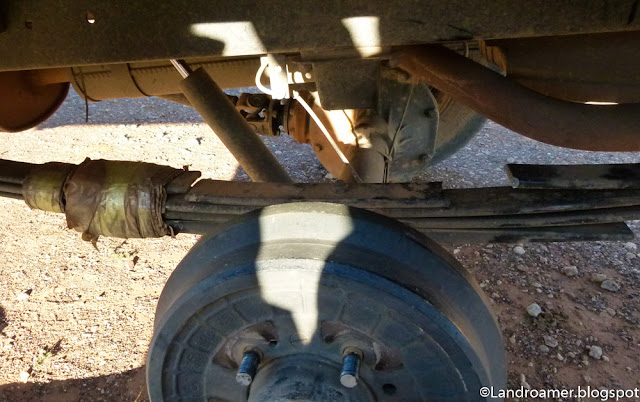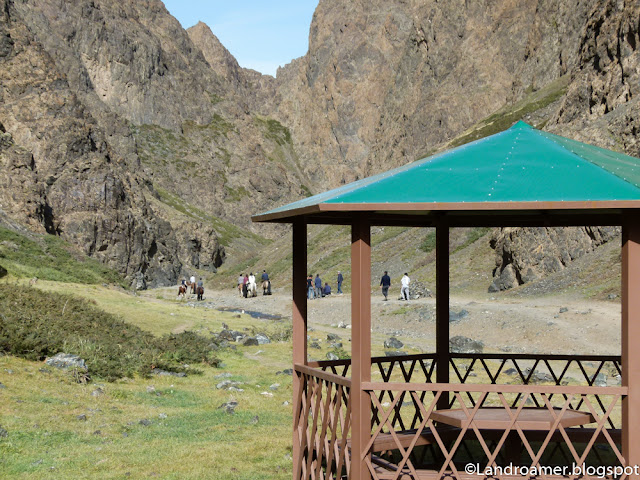The Gobi Desert is a large desert region in Asia. It covers parts of northern and northwestern China, and of southern Mongolia. The desert basins of the Gobi are bounded by the Altai Mountains and the grasslands and steppes of Mongolia on the north, by the Taklamakan Desert to the west, by the Hexi Corridor and Tibetan Plateau to the southwest, and by the North China Plain to the southeast.
The Gobi is notable in history as part of the great Mongol Empire, and as the location of several important cities along the Silk Road.
The Gobi is a rain shadow desert, formed by the Tibetan Plateau blocking precipitation from the Indian Ocean reaching the Gobi territory.
Because my
Land Roamer was “stuck” in Ulaan Bator, waiting for new tires to arrive, I decided
to join a visit to the Gobi desert, organised by “UB Guest House & Tours”.
Two young students from Germany were on the same tour; having a small group was
very nice. Mongolia is big, we drove 1900 km in 6 days, many of these on bumpy
roads. The Bukhanka was more comfortable than I expected.
UAZ-452 (УАЗ-452), also called Bukhanka (pan loaf) or Tabletka (taplett, pill).
The UAZ-452 is a family of off-road vans produced at the Ulyanovsk Automobile Plant (UAZ) since 1965. Its predecessor model UAZ-450 (produced between 1958-1966) was based on the chassis and engine of the GAZ-69 jeep, and was the first "forward control" vehicle of this type to be built in the Soviet Union and Russia
Day 1: snow and ice as we leave Ulaan Bator
The scarp
of Tsagaan Suvarga is located in Ulziit soum of Dundgovi province. It is
interesting to see the sheer slope, facing east, which from a distance seems to
be the ruins of the ancient city. The cliff is 30 meters high and 100 meters
wide. Over thousands of years the wind has created this amazing structure.
It is sheer
slope and was an old seabed with sedimentary structure created by millions
years and the different colors of the ground represent different times.
The
formation is over 50m in its highest point and continues 400m
YES! Harleys CAN go to the Gobi!
Bukhankas are easy to repair, BUT they need frequent (daily?) mechanical attention...
This the way to get camel milk!
The adult camels, wait patiently for their turn to be milked...
DAY 2
Mid-day stop to cook lunch!
The Flaming Cliffs site, also known as Bayanzag, in a location where important fossil finds have been made. It was given this name by American paleontologist Roy Chapman Andrews, who visited in the 1920s. The area is most famous for yielding the first discovery of dinosaur eggs. Other finds in the area include specimens of Velociraptor and eutherian mammals.
Day 3
Khongoryn Els is popularly known as the "Singing Sands". It lies within the Gobi Gurvansaikhan National Park in Mongolia. The sand dunes extend to over 965 square kilometres.
Day 4
Yolyn Am is a deep and narrow gorge in the Gurvan Saikhan Mountains of southern Mongolia. The valley is named after the Lammergeier, which is called Yol in Mongolian. The Lammergeier is an Old World vulture, hence the name is often translated to Valley of the Vultures or Valley of the Eagles.
The valley is located within Gobi Gurvansaikhan National Park.The area, as part of the Gobi Desert, sees little precipitation. However, Yolyn Am is notable for a deep ice field. The ice field reaches several meters thick by the end of winter, and is several kilometers long. In past years it remained year round, but the modern ice field tends to disappear by September.
Day 5
Hail and rain storms !!!
Day 6
Baga Gazriin Chuluu – located in Delgertsogt sum, Dundgovi province and surrounded by plain. The highest one is 15 km long and 10 km wide granite stone-mountain elevated at 1768m above sea level. There is a ruin of Choir monastery which was established by “Zava” Damdin, a famous ancient historical, religious and scientific researcher. This monastery had a monastery with few monks translate, print, explain and advertise books from Tibetan languages and research religious philosophy and medical science.











































































